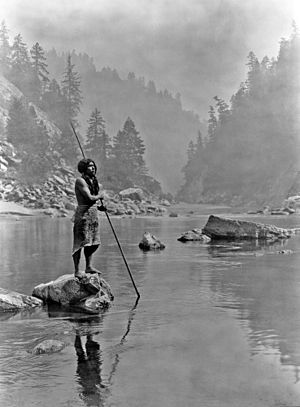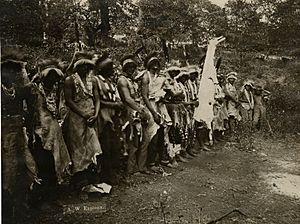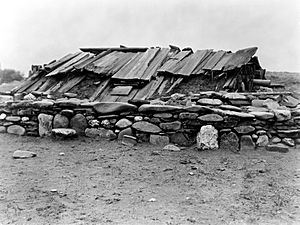Hupa facts for kids
| dining’xine:wh / na:tinixwe | |
|---|---|

A Hupa man by Edward S. Curtis, c. 1923
|
|
| Total population | |
| 3139 enrolled (2013) | |
| Regions with significant populations | |
| Languages | |
| English, Hupa | |
| Religion | |
| Hupa traditional beliefs, Christianity | |
| Related ethnic groups | |
| Chilula and Whilkut |
The Hupa are a group of Native American people who live in northwestern California. They speak a language from the Athabaskan language family. The Hupa people call themselves dining’xine:wh (which means Hupa-language speakers) or na:tinixwe (meaning "People of the Place Where the Trails Return"). Most Hupa people today are part of the Hoopa Valley Tribe, which is officially recognized by the United States government.
Contents
Discovering the Hupa People
A Journey Through Hupa History
The Hupa people moved from the north into northern California around the year 1000 CE. They settled in a beautiful area now known as Hoopa Valley, California. Their traditional language is Hupa, which is part of the large Athabaskan language family.
Early Life and Traditions
The Hupa people's land stretched from the South Fork of the Trinity River to Hoopa Valley and then to the Klamath River in California. Their homes were built from red cedar planks. They also used dugout canoes for travel and made special basket hats. Many of their stories and traditions connect them to their northern origins. However, they also adopted some customs from other indigenous peoples of California. These included using a sweat house for important ceremonies and making delicious acorn bread.
Protecting Their Homeland
The Hupa people had little contact with non-native people until the 1849 Gold Rush. This event brought many miners to their lands. In 1864, the United States government signed a treaty. This treaty recognized the Hupa tribe's right to their land. The government named this area the Hoopa Valley Indian Reservation.
The Hupa people still live on this reservation today. It is one of the few California tribes that was not forced to leave its original homeland. The reservation is located next to the Yurok territory. It sits where the Klamath and Trinity Rivers meet in northeastern Humboldt County. The reservation covers about 141 square miles.
The Hupa people have been actively involved in discussions about removing hydroelectric dams along the Klamath and Trinity rivers. They were part of a lawsuit to protect the rivers. In February 2017, a federal judge ruled in favor of the Hoopa Valley Tribe and other fishing tribes. The judge approved plans developed by the tribes' scientists. These plans aimed to reduce a deadly fish disease that had harmed young salmon in previous years.
Hupa Culture and Daily Life
Amazing Hupa Arts
Hupa people have been skilled artists for centuries. Since the 1600s, they have created beautiful basketry and carved intricate designs into elk horns. They also made petroglyphs, which are images carved into rocks.
Plants and Their Uses
Traditionally, the Hupa people used acorns from the Notholithocarpus densiflorus tree. They ground these acorns into a meal. From this meal, they made mush, bread, biscuits, pancakes, and cakes. They also enjoyed roasting and eating the acorns. For their basketry, they used the dyed fronds (leaves) of the Woodwardia radicans fern. They also used Xerophyllum tenax to create special border patterns in their baskets.
Fishing for Survival
Like many tribes in their region, the Hupa people fished for salmon in the Klamath and Trinity rivers. One traditional method they used was a fish weir. This was a structure built in the river to help catch fish, and tribal members worked together to maintain it. The Hupa shared many fishing practices with their neighbors, the Yurok. Hupa fishers and their families relied on the Spring and Fall runs of Chinook Salmon. Acorns were once a very important food source, but they became harder to find. Since the Hupa lived further from the sea than the Yurok, they often traded with them. For example, they might trade baskets or acorns for salt or canoes.
Where Hupa People Live Today
Historians have estimated the number of Hupa people before European contact. Alfred L. Kroeber thought there were about 1,000 Hupa in 1770. Today, the Hoopa Valley Indian Reservation is home to many Hupa descendants. According to the 2000 census, 2,633 people lived there.
Hupa descendants are mainly part of the Hoopa Valley Indian Reservation and other tribes. These include:
- Hoopa Valley Tribe (na:tinixwe) (Hoopa, Humboldt County, Population 2013: 3,139). This tribe includes Hupa, Tsnungwe, Chimalakwe, Chilula, and Whilkut people.
- Cher-Ae Heights Indian Community of the Trinidad Rancheria (Trinidad, Humboldt County, Population 2011: 154). This community includes Yurok, Wiyot, Tolowa, Chetco, Hupa, and Karuk people.
- Blue Lake Rancheria (yisinch’in) (Blue Lake, Humboldt County, Population 2010: 58). This rancheria includes Wiyot, Yurok, Hupa, and Whilkut people.
See also
 In Spanish: Hupa para niños
In Spanish: Hupa para niños
- Hoopa, California—the town in the Hupa Valley.





